“Gimme an F, Gimme a W, Gimme a . . . Huh?”
It’s a tale of east and west. And when I say “east and west” I mean, of course, north and south.
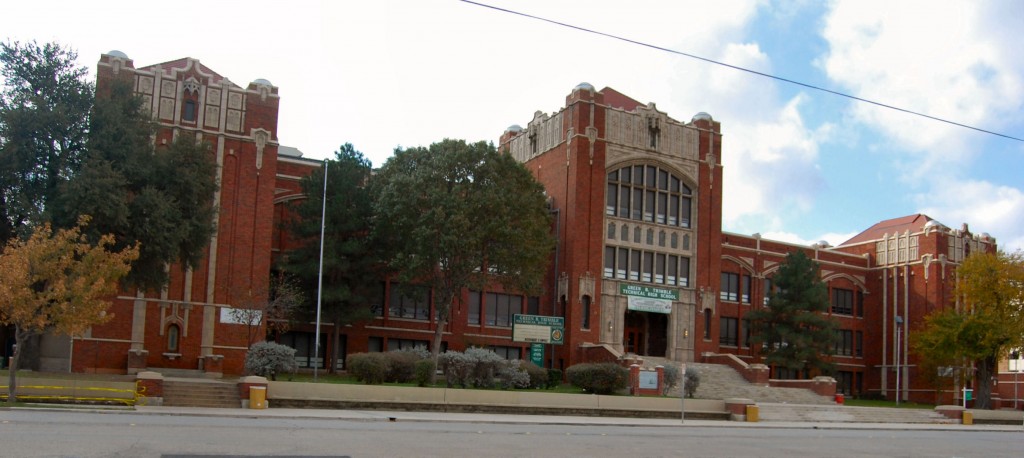 Schools in Fort Worth—and the land they are located on—can have a complicated history. Take, for example, this school building and its block, bounded by College Avenue and Cannon, Henderson, and Dashwood streets. First the school was called “Fort Worth High School/”Central High School” (1918), then “Paschal High” (1935), then “Technical High School” (1955), and finally “Green B. Trimble Technical High School” in 1966.
Schools in Fort Worth—and the land they are located on—can have a complicated history. Take, for example, this school building and its block, bounded by College Avenue and Cannon, Henderson, and Dashwood streets. First the school was called “Fort Worth High School/”Central High School” (1918), then “Paschal High” (1935), then “Technical High School” (1955), and finally “Green B. Trimble Technical High School” in 1966.
But wait! There’s more. Often we don’t stop to wonder how streets got their name. Take, for example, College Avenue, which stretches from Vickery Boulevard south to Felix Street but doesn’t come close to so much as a barber college. Ah, but for thirty years it did. Long before that block was occupied by a high school, the intersection of College Avenue and Cannon Street was the location of the ten-acre campus of . . .
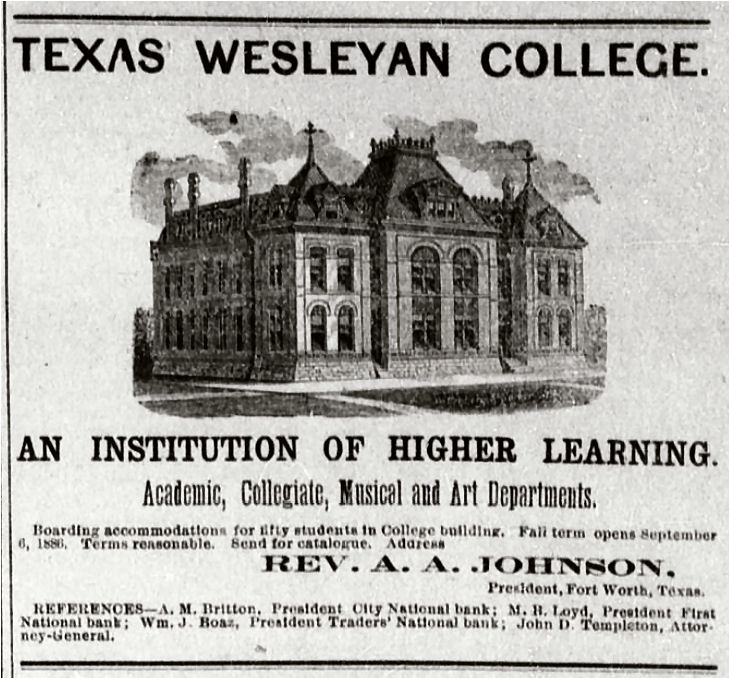
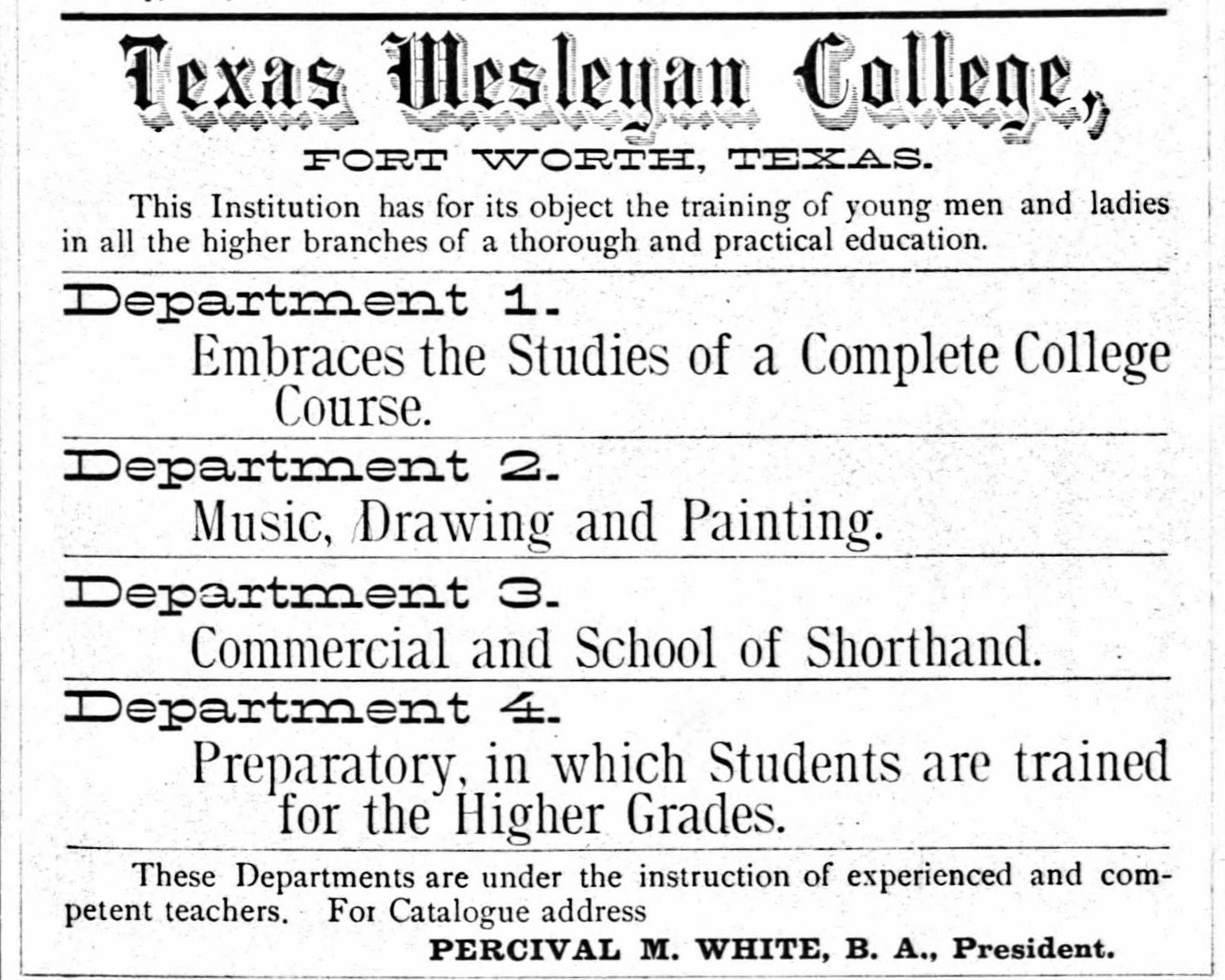 Texas Wesleyan College. No, not that Texas Wesleyan College—not the one on the East Side. This Texas Wesleyan College was chartered by the northern Methodist Church in 1881.
Texas Wesleyan College. No, not that Texas Wesleyan College—not the one on the East Side. This Texas Wesleyan College was chartered by the northern Methodist Church in 1881.
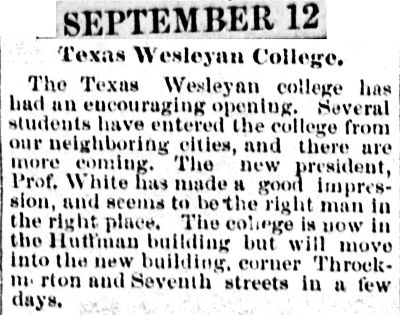 This TWC opened in September 1883. It was located in temporary quarters downtown until its permanent campus was completed on the near South Side in 1886. And in 1889 this TWC changed its name to . . .
This TWC opened in September 1883. It was located in temporary quarters downtown until its permanent campus was completed on the near South Side in 1886. And in 1889 this TWC changed its name to . . .
 “Fort Worth University,” as shown on this 1910 Sanborn map. Cannon Street is named for one of the school’s benefactors, William H. Cannon. Terrell Avenue is named for J. C. Terrell, who was instrumental in selection of the site of the university on forty acres of land just north of his home. Reverend A. A. Johnson and Cannon, then a traveling shoe salesman from Philadelphia, bought the forty acres and sold lots on the land to finance construction of the university buildings on the remainder of the acreage.
“Fort Worth University,” as shown on this 1910 Sanborn map. Cannon Street is named for one of the school’s benefactors, William H. Cannon. Terrell Avenue is named for J. C. Terrell, who was instrumental in selection of the site of the university on forty acres of land just north of his home. Reverend A. A. Johnson and Cannon, then a traveling shoe salesman from Philadelphia, bought the forty acres and sold lots on the land to finance construction of the university buildings on the remainder of the acreage.
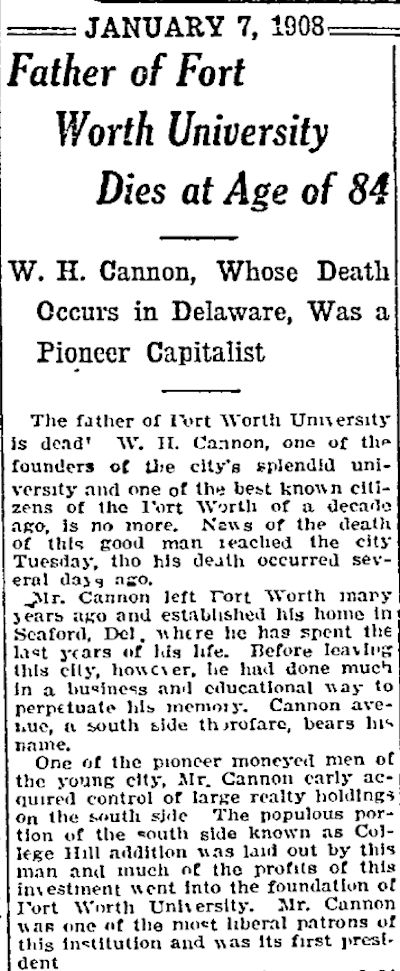 Cannon’s obituary in 1908 said he was the first president of Fort Worth University. I believe he was the first president of the university’s board of directors. I also find no evidence that he ever lived in Fort Worth. Newspapers of the time referred to him as “of Philadelphia.”
Cannon’s obituary in 1908 said he was the first president of Fort Worth University. I believe he was the first president of the university’s board of directors. I also find no evidence that he ever lived in Fort Worth. Newspapers of the time referred to him as “of Philadelphia.”
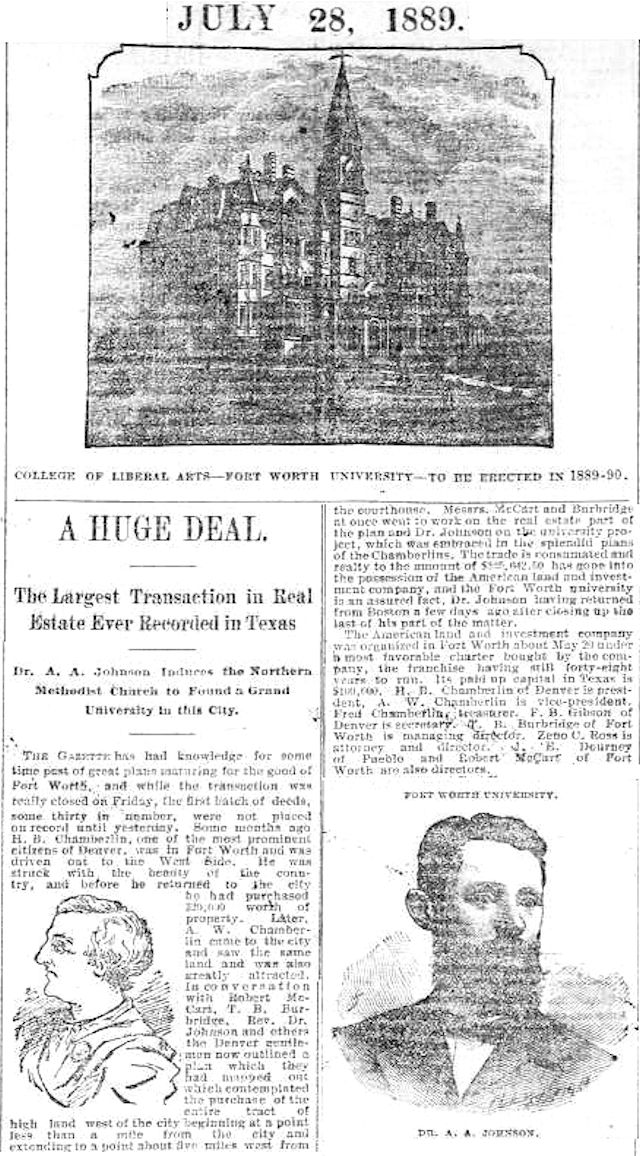 In 1889 Humphrey Barker Chamberlin, a British-born Denver developer, announced for Fort Worth plans for what the Gazette called, hyperbolically, “the largest transaction in real estate ever recorded in Texas.” But Chamberlin did indeed have three grand plans: 1. to develop the area west of Fort Worth residentially as “Arlington Heights” and link Arlington Heights to Fort Worth with his Fort Worth and Arlington Heights Street Railway, 2. to build a grand hotel for Arlington Heights, and 3. to relocate Texas Wesleyan College, which had just been rechartered as “Fort Worth University,” from its near South Side location to a new campus in Arlington Heights.
In 1889 Humphrey Barker Chamberlin, a British-born Denver developer, announced for Fort Worth plans for what the Gazette called, hyperbolically, “the largest transaction in real estate ever recorded in Texas.” But Chamberlin did indeed have three grand plans: 1. to develop the area west of Fort Worth residentially as “Arlington Heights” and link Arlington Heights to Fort Worth with his Fort Worth and Arlington Heights Street Railway, 2. to build a grand hotel for Arlington Heights, and 3. to relocate Texas Wesleyan College, which had just been rechartered as “Fort Worth University,” from its near South Side location to a new campus in Arlington Heights.
Well, Chamberlin plans 1 and 2 eventually came about, even if the hotel, Ye Arlington Inn, burned in 1894. But plan 3 never came about, and Fort Worth University stayed right where it was.
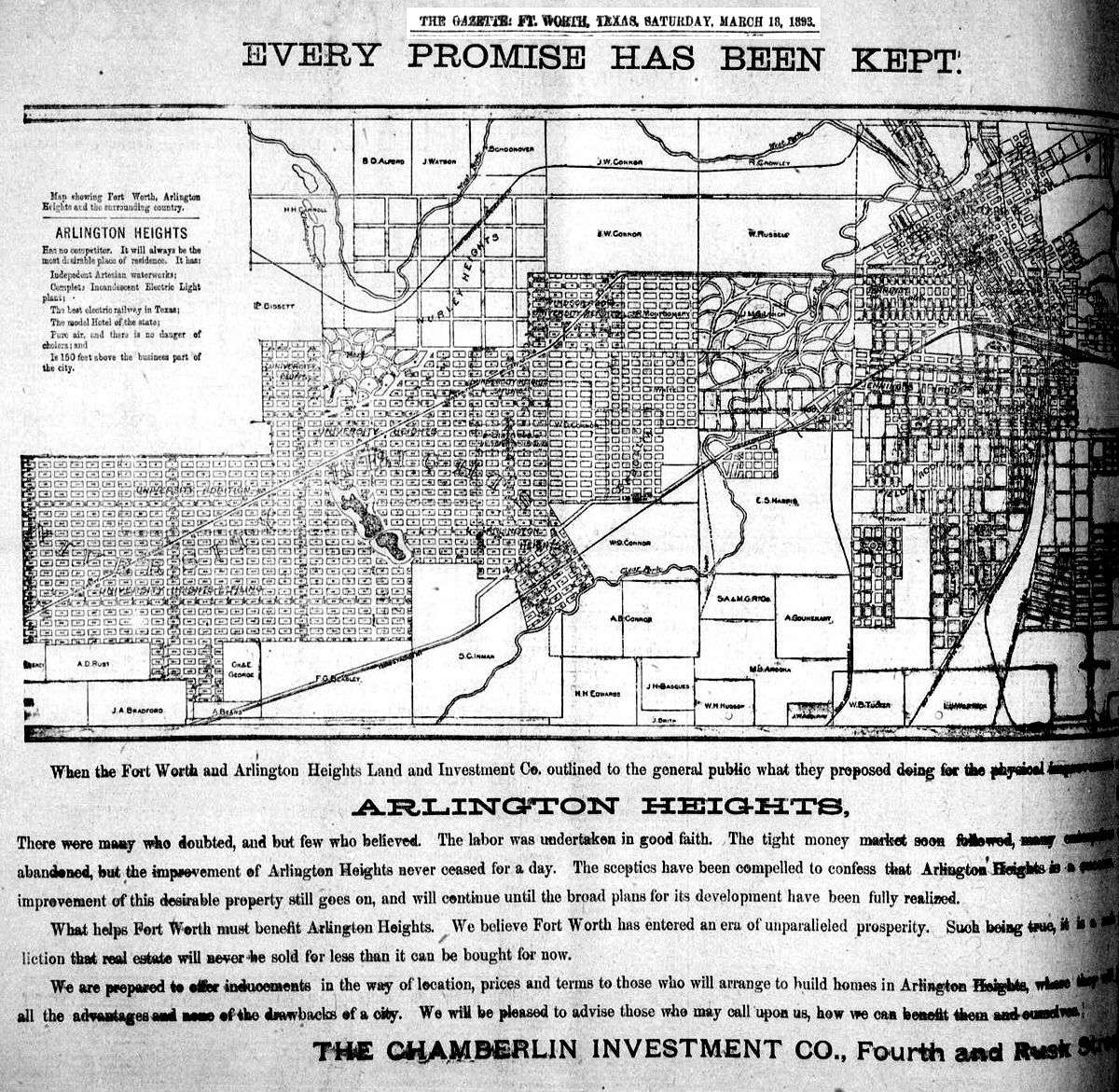 But the western part of Arlington Heights around Lake Como was platted as “University Heights” for the college that never came.
But the western part of Arlington Heights around Lake Como was platted as “University Heights” for the college that never came.
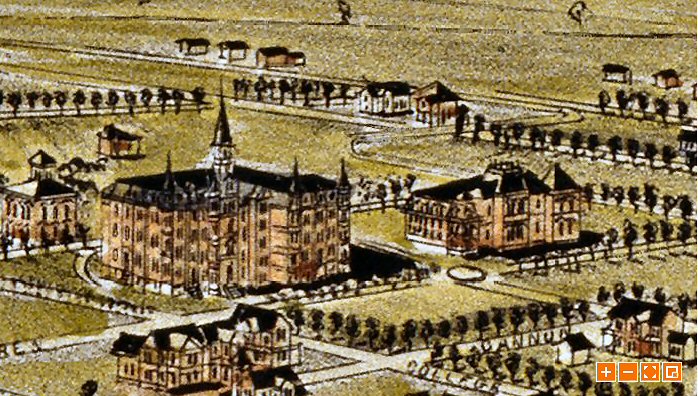 Henry Wellge’s bird’s-eye-view map shows FWU in 1891. In 1910 an attempt was made to merge Fort Worth University with Polytechnic College, which is the TWC you were thinking of. Polytechnic College had been founded on the east side of town in 1890 by the southern Methodist Church and would become Texas Woman’s College in 1914, Texas Wesleyan College in 1935, and Texas Wesleyan University in 1989.
Henry Wellge’s bird’s-eye-view map shows FWU in 1891. In 1910 an attempt was made to merge Fort Worth University with Polytechnic College, which is the TWC you were thinking of. Polytechnic College had been founded on the east side of town in 1890 by the southern Methodist Church and would become Texas Woman’s College in 1914, Texas Wesleyan College in 1935, and Texas Wesleyan University in 1989.
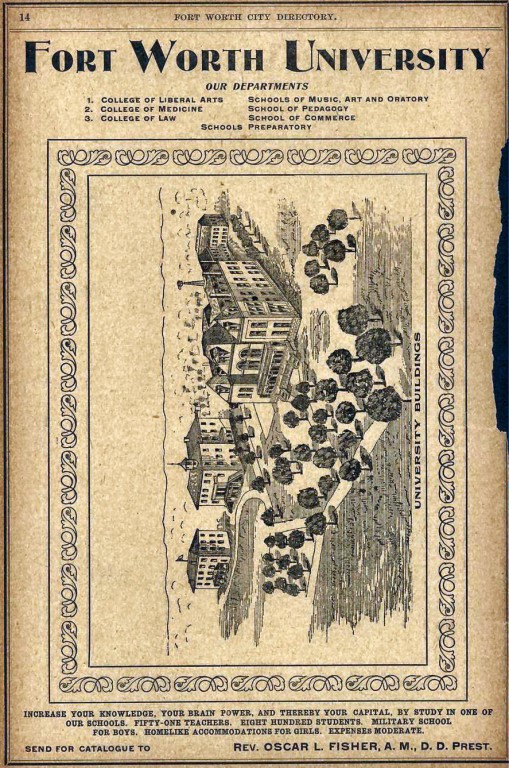
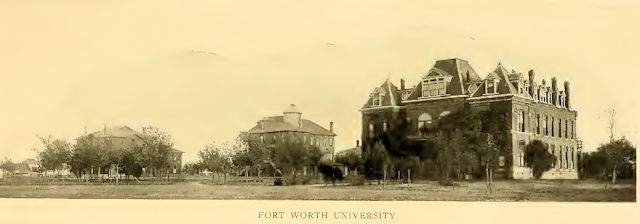 But back to Fort Worth University. It was small but robust. College president Oscar L. Fisher advertised, “Increase your knowledge, your brain power, and thereby your capital by study in one of our schools. Fifty-one teachers, eight hundred students. Military school for boys. Homelike accommodations for girls. Expenses moderate.”
But back to Fort Worth University. It was small but robust. College president Oscar L. Fisher advertised, “Increase your knowledge, your brain power, and thereby your capital by study in one of our schools. Fifty-one teachers, eight hundred students. Military school for boys. Homelike accommodations for girls. Expenses moderate.”
“Moderate,” indeed, by today’s standards. In 1903 tuition was less than $200. Room and board was $3.50 a week.
The FWU campus had four buildings: Dining Hall, Science Hall, University Hall, and Cadet Hall. The college offered such arts and sciences courses as modern languages, business, instrumental and vocal music, drawing and painting, elocution, mathematics, Latin and Greek, biology, chemistry, and astronomy. In 1890 the university added a cadet corps.
In fact, the university was set up to be potentially the only school a child would ever need, offering classes from kindergarten through postgraduate. Degrees included AB, BS, BLitt, DD, and PhD.
Outdoor activities included baseball, croquet, lawn tennis, and football.
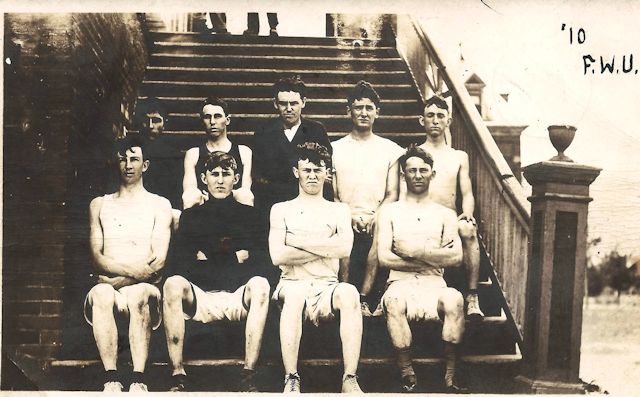 An unidentified FWU team. (Photo from Barbara Love Logan.)
An unidentified FWU team. (Photo from Barbara Love Logan.)
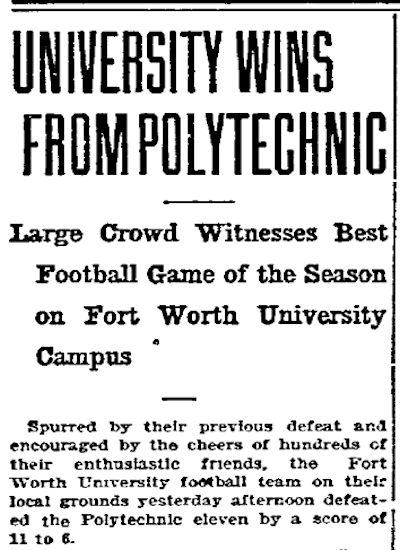 For example, on November 26, 1903 Fort Worth University (which had been the northern Methodist TWC) beat Polytechnic College (which would become the southern Methodist TWC) at home in football. Clip is from the November 27 Fort Worth Telegram.
For example, on November 26, 1903 Fort Worth University (which had been the northern Methodist TWC) beat Polytechnic College (which would become the southern Methodist TWC) at home in football. Clip is from the November 27 Fort Worth Telegram.
The FWU yearbook was The Lasso. Each class had its own colors and yell. For example, the senior class colors were navy blue and gold. The senior class yell was:
Ring! Rah! Ru! Do your do! Varsity! Varsity? Fort Worth U!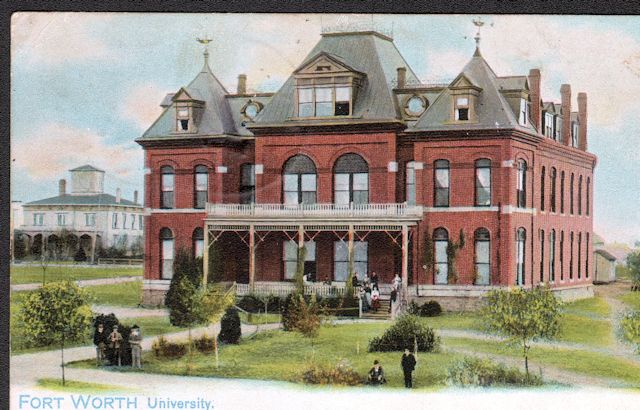 Postcard from Pete Charlton.
Postcard from Pete Charlton.
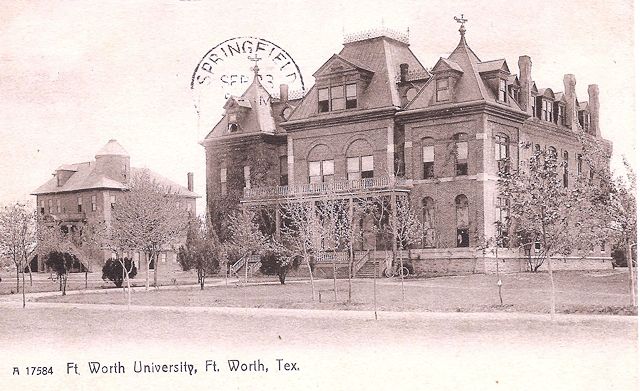 Postcard from Barbara Love Logan.
Postcard from Barbara Love Logan.
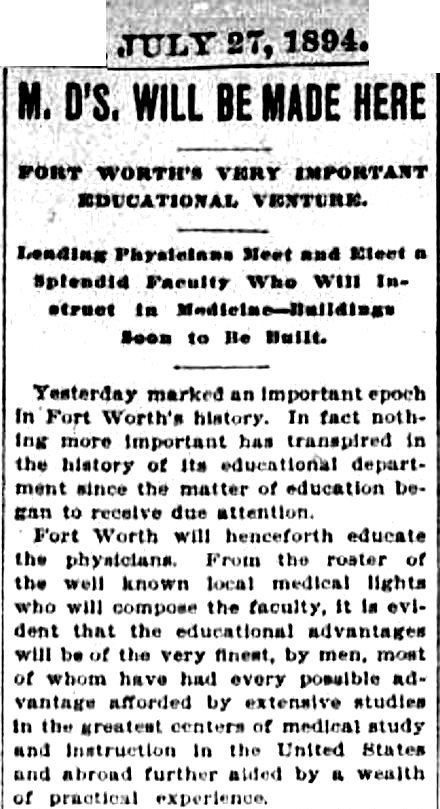
FWU opened a school of law in 1893 and a school of medicine in 1894. On July 27, 1894 the Fort Worth Gazette announced that FWU would open its medical college.

The medical college was originally located on the College Avenue campus but in 1896 moved to a building downtown at Commerce and 7th streets (pictured). (Photo from University of Texas at Arlington Library.)
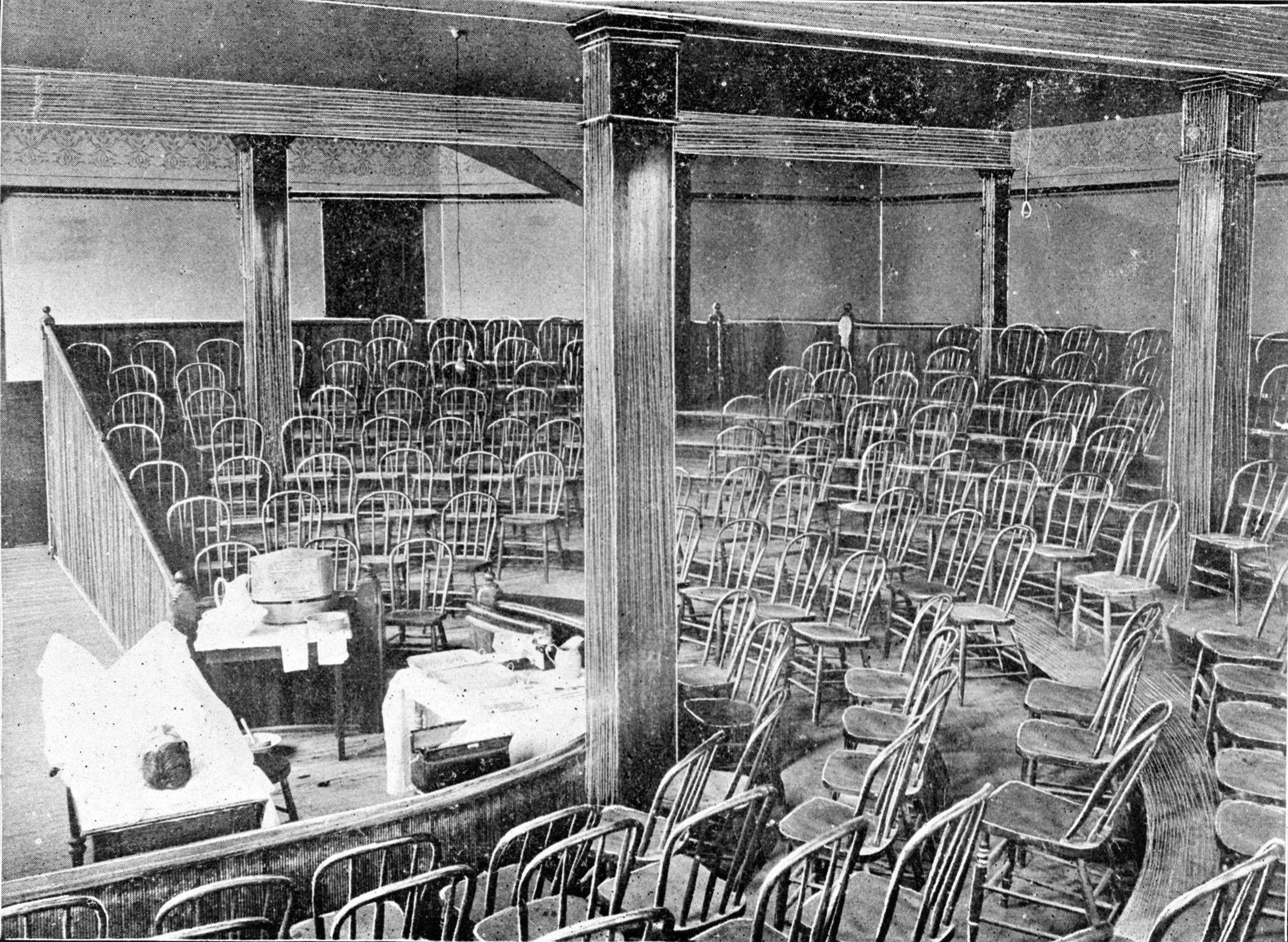
The amphitheater of the medical college was located on the first floor. Photo is from the school’s 1898 yearbook. (Photo from University of Texas at Arlington Library.)
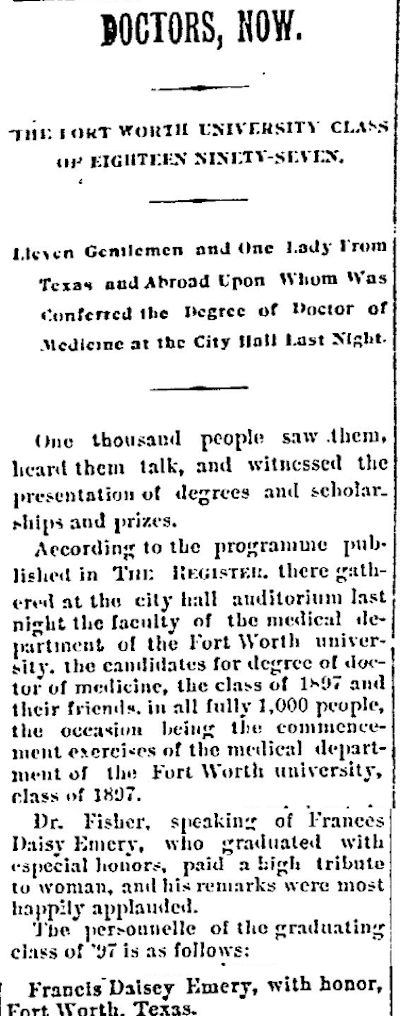
On April 1, 1897 the medical school graduated its first class of students who had gone through the entire three-year medical course at FWU. Clip is from the April 2, 1897 Fort Worth Register.
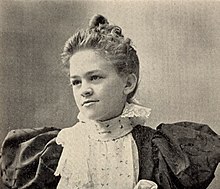
That graduating class was a dozen students, including Frances Daisy Emery Allen (pictured). Allen, a graduate of Fort Worth High School, graduated second in her class at the medical college, becoming the first woman to graduate from a Texas medical school. She taught at the medical college and was on the staff of Harris, All Saints, and St. Joseph’s hospitals. (Photo from Wikipedia.)
In 1903 tuition at the medical college, “including matriculation fee, dissecting ticket, chemical, and pathological laboratories,” was seventy-five dollars a year.
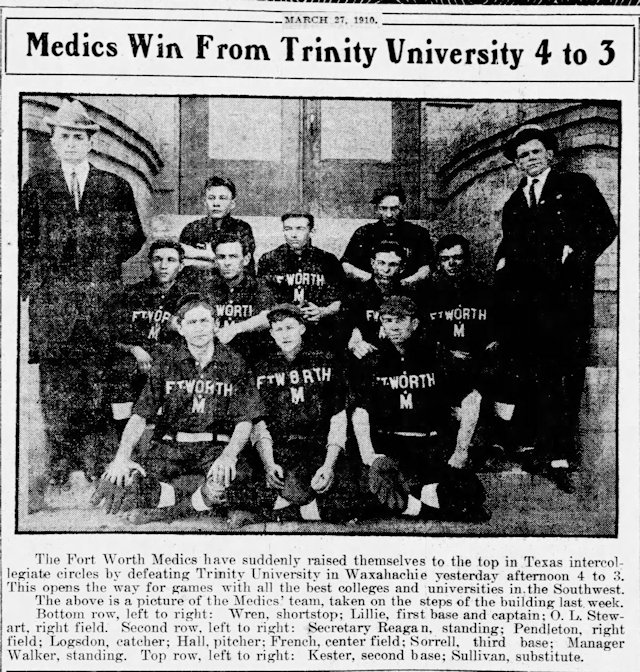 The medical college had a baseball team, the Fort Worth Medics.
The medical college had a baseball team, the Fort Worth Medics.
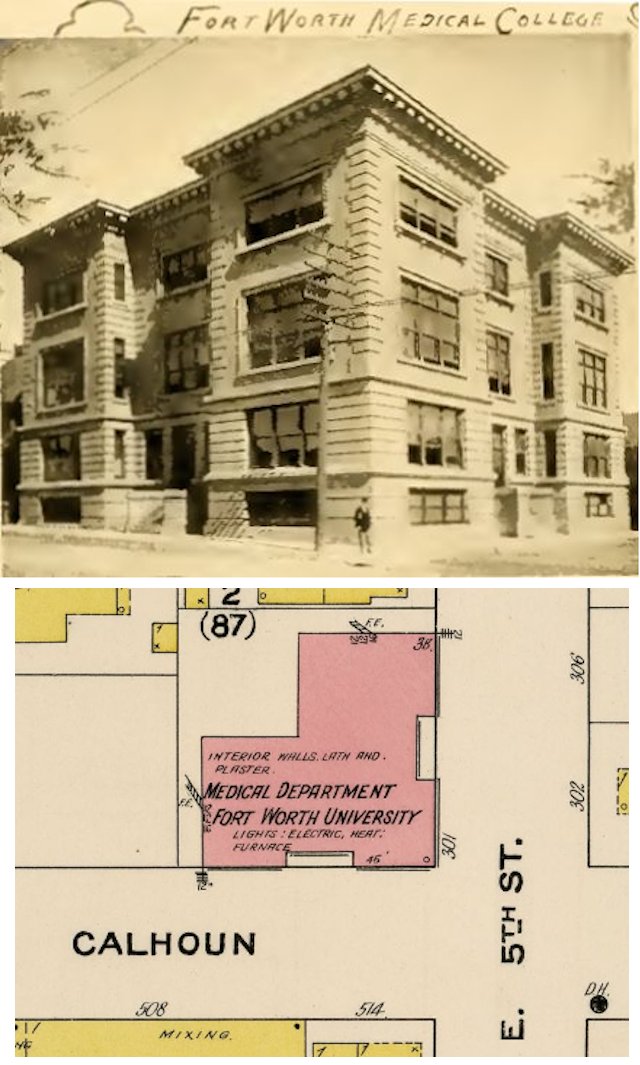
In 1906 the medical college moved to a building at Calhoun and East 5th streets.
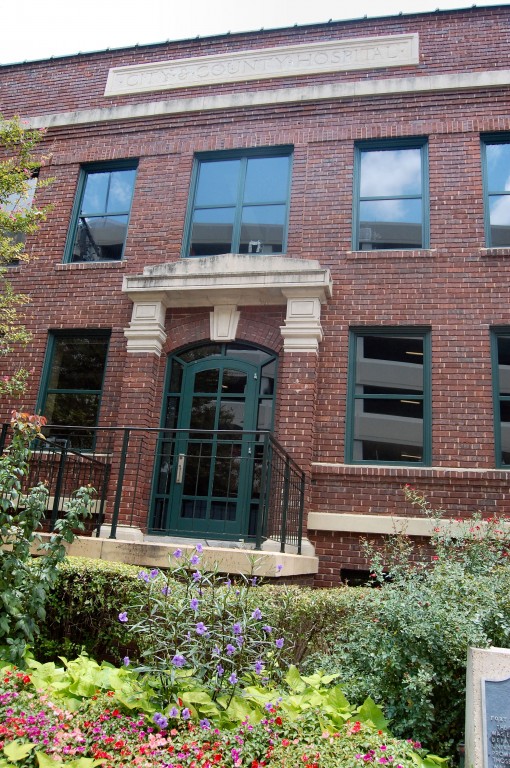 In 1914 the medical college began using City-County Hospital, which opened at East 4th and Jones streets.
In 1914 the medical college began using City-County Hospital, which opened at East 4th and Jones streets.
Meanwhile back on College Avenue, in 1911, when the attempted merger of Fort Worth University (which, remember, had been the western TWC founded by the northern Methodists) and Polytechnic College (which, remember, would become the eastern TWC founded by the southern Methodists) failed, FWU said to heck with it and became part of Methodist University of Oklahoma. (Are you getting all this?) Fort Worth University on College Avenue closed. Another factor in the closing of FWU was the relocation of Texas Christian University from Waco to Fort Worth in 1910, presenting FWU with new competition for students. Upon closure of the FWU campus, the Star-Telegram reported, FWU trustees reflected on “a useful, honorable career of twenty-nine years.”
In a move that must have galled those trustees, with closure of Fort Worth University, the university’s medical school, which had been chartered separately, in 1911 became affiliated with the competition: TCU. But in 1918 the medical college became affiliated with Baylor University in Dallas.
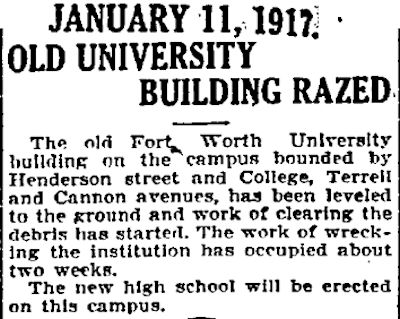 In 1917 the Fort Worth school district demolished the last building of the Fort Worth University campus to build Central High School (now Trimble Technical High School) to alleviate pressure on Fort Worth High School on Jennings Avenue, which had been built to replace the original Fort Worth High School on Daggett Street.
In 1917 the Fort Worth school district demolished the last building of the Fort Worth University campus to build Central High School (now Trimble Technical High School) to alleviate pressure on Fort Worth High School on Jennings Avenue, which had been built to replace the original Fort Worth High School on Daggett Street.
My head hurts.






I have my Grandma’s yearbook from Central High School from 1921…I knew the name changed to Paschal (where I taught at the current location) but never knew it was Trimble where my mother graduated! How cool is that?
A century-old yearbook. What a time capsule.
Those two buildings have such a complicated history.
Can you give citations for all the photos that you posted on here.
Contemporary photos are my own. The uncredited images are from Fort Worth newspapers, city directories, Sanborn fire maps, Greater Fort Worth.
This is an excellent essay, however, in one regard it is incorrect. Dr. Frances Daisy Emery Allen was not one of the first women to be licensed in Texas. In Fort Worth alone, at least 12 women practicing in Fort Worth had been licensed before she entered medical school. In fact, there were 4 different women with M. D. degrees who had practices in the city. Dr. Ellen Lawson Dabbs was the longest term of these and practiced in the city most of the time between 1892-1905. See my chapter in Texas Women: Their Histories, Their Lives. Also, though Dr. Allen was licensed in Tarrant County, she did not practice in the county until 1912.
Thank you. In my limited research on Dr. Allen for this post I found her described as “pioneering physician,” “one of the first female physicians to practice in Tarrant County,” and “worked in private practice in Fort Worth for two years, making her one of the first female physicians in the Tarrant County” (Wikipedia); “became one of the first female doctors in Tarrant County” (biographical note at Tarrant County’s website); “pioneer of medicine” (Fort Worth Genealogical Society’s journal Footprints; “early female physician” (Kassie M. Dixon’s thesis); and even “was the County’s first female doctor” (Les Crocker’s The Tarrant County Historical Journal website) and “the first female physician in the state” (Bill Fairley’s column in the Star-Telegram).
The term “the first,” of course, is pretty specific (and in this case inaccurate, I suspected), but, as you know, terms such as “pioneering/pioneer,” “one of the first,” and “early” are subjective and thus applied generously by some people and narrowly by other people.
Thanks for your insight. I have made that correction.
In 1955 Trimble Tech did not exist. The school was Fort Worth Technical High School. Referred to as simply Tech. Mr Green B Trimble was the principal. The school was renamed to honor him sometime after he retired in 1966.
Thank you. I have made that correction. The chronology of the names of the building is correct in the other two posts about the school.
All the shuffling is around the time the Flexner Report was published. Flexner’s recommendations included requiring students to have a minimum of a high school diploma, closing physician owned schools, standardizing curricula. Interesting that the school admitted a female in the 1890’s.
Thanks for writing this.
I’ve heard this story a handful of times now, and my head STILL hurts.
Doohickie, it’s a story that’s more fun to tell than to listen to.